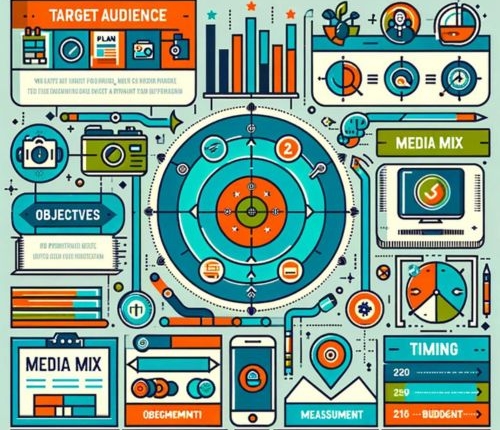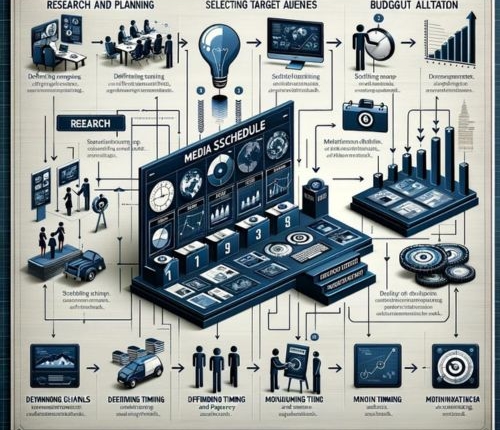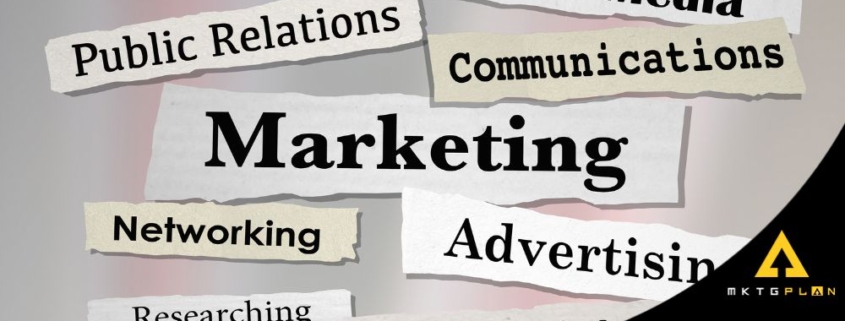How a Media Plan Can Transform Your Marketing Strategy
Unlock Your Brand’s Potential with a Media Plan
Welcome to the world of digital marketing, where brand visibility is crucial for impactful results. In today’s competitive landscape, having a well-structured media plan is the key to unlocking your brand’s potential and reaching your target audience effectively. A media plan, as part of your marketing strategy, can elevate your brand visibility and maximize your marketing efforts.
A media plan encompasses a strategic roadmap that outlines how, when, and where your brand’s message will be communicated to your target audience. It serves as a blueprint to guide your marketing activities, ensuring that your brand is visible across various media channels that resonate with your audience.
By developing a media plan, you can gain valuable insights into your target audience, identify the most impactful media channels, allocate your budget effectively, and create a well-orchestrated schedule. It’s about making informed decisions based on data and analytics, enabling you to optimize your brand’s visibility and achieve the desired results.
Throughout this article, we will explore the importance of a media plan and its various components. We will delve into target audience analysis, media channel selection, budget allocation, media buying, and developing a cohesive media schedule. We will also highlight the significance of integrating online and offline media strategies and the importance of measuring and analyzing your media plan’s performance.
So, if you’re ready to take your brand to the next level, join us on this journey as we unlock the full potential of your brand with a well-crafted media plan. Let’s dive in and discover how to enhance your brand’s visibility, engage your audience, and achieve impactful results.
What is a Media Plan?
A media plan is a strategic document that outlines how a brand’s marketing message will be delivered to its target audience through various media channels. It serves as a roadmap for effectively utilizing advertising resources to maximize brand visibility and achieve desired marketing objectives.
Creating a media plan involves a meticulous analysis of target audience demographics, market trends, and competitor strategies. The plan incorporates a combination of online and offline media channels, such as television, radio, print, digital, social media, and outdoor advertising, to ensure a comprehensive reach.
“A media plan is like a master puzzle, where each piece represents a carefully selected media channel that contributes to the overall impact and success of a brand’s marketing strategy.”
By strategically selecting the right media channels and optimizing budget allocation, a media plan enables brands to engage with their target audience at the right time and in the right place. It ensures that marketing messages are delivered with the maximum impact, capturing the attention of potential customers and driving desired actions.

Benefits of a Media Plan:
- Enhances brand visibility
- Increases the reach of marketing messages
- Maximizes the impact of advertising efforts
- Improves targeting and personalization
- Optimizes budget allocation
- Provides a framework for measuring and analyzing marketing performance
Whether you’re a small startup or an established company, developing a well-structured media plan is crucial for achieving marketing success. It ensures that your brand’s message is effectively delivered to the right audience, maximizing visibility and driving impactful results.
| Media Channels | Description |
|---|---|
| Television | Reach a broad audience with visual and audio advertising. |
| Radio | Engage with listeners through audio advertisements and sponsorships. |
| Create brand awareness through newspaper and magazine advertisements. | |
| Digital | Utilize online platforms like websites, display ads, and email marketing. |
| Social Media | Connect with a targeted audience through platforms like Facebook, Instagram, and Twitter. |
| Outdoor Advertising | Generate brand visibility through billboards, bus shelters, and signage. |
The Purpose of a Media Plan
A media plan serves as a strategic blueprint that guides the allocation of resources and efforts to enhance brand visibility and support a well-rounded marketing strategy. By carefully crafting a media plan, you can effectively reach your target audience, maximize your brand’s exposure, and amplify the impact of your marketing initiatives.
The primary goal of a media plan is to ensure that your brand’s message reaches the right people at the right time through the most appropriate channels. It involves meticulous research, analysis, and decision-making to determine the optimal mix of media platforms that will effectively engage your target audience and deliver measurable results.
With a well-designed media plan in place, you can create a comprehensive roadmap that outlines the specific actions needed to achieve your marketing objectives. Whether it’s increasing brand awareness, driving website traffic, or generating leads, a media plan helps you navigate through the vast landscape of advertising options and make informed choices that align with your overall marketing strategy.
Moreover, a media plan facilitates efficient budget allocation, ensuring that your marketing dollars are optimally spent. By carefully considering factors such as reach, frequency, and cost-effectiveness, you can make strategic decisions about where to invest your resources for maximum impact.
A media plan also enables you to measure the performance of your marketing efforts and make data-driven adjustments. By monitoring key metrics and analyzing the outcomes of your campaigns, you can identify what works and what doesn’t, allowing you to refine your strategies and achieve better results over time.
In summary, a media plan is an essential tool for any brand looking to enhance its visibility and create an effective marketing strategy. By developing a well-thought-out media plan, you can ensure that your brand’s message reaches the right audience, through the right channels, at the right time, ultimately driving growth and success.
Components of a Media Plan

A media plan is composed of various strategic components that work together to maximize brand visibility and drive impactful results. In this section, we will explore the key elements that make up a well-rounded media plan.
1. Target Audience Analysis
To effectively reach your target audience, it is crucial to conduct thorough research and analysis. By understanding customer demographics, behaviors, and preferences, you can tailor your media plan to resonate with your audience and capture their attention.
2. Media Channels
Choosing the right media channels is essential for successful brand promotion. Whether it’s traditional channels like TV, radio, and print, or digital platforms such as social media, websites, and mobile apps, selecting the most suitable channels will ensure that your message reaches your intended audience effectively.
3. Budget Allocation
Allocating your budget wisely is a critical aspect of a media plan. By carefully assessing your marketing goals and considering the cost and reach of different media channels, you can optimize your budget to achieve the maximum return on investment (ROI).
4. Scheduling
A well-structured media schedule helps you maintain consistency and reach your audience at the right time, increasing the chances of successful engagement. By strategically determining the timing and frequency of your media placements, you can build momentum and sustain brand visibility.
| Component | Description |
|---|---|
| Target Audience Analysis | Conduct research and analysis to understand customer demographics, behaviors, and preferences. |
| Media Channels | Select the most suitable media channels, including traditional and digital platforms, to reach your target audience effectively. |
| Budget Allocation | Allocate your budget wisely by considering your marketing goals, cost, and reach to optimize ROI. |
| Scheduling | Determine the timing and frequency of your media placements to build engagement and sustain brand visibility. |
By incorporating these components into your media plan, you can create a comprehensive and effective strategy that maximizes your brand’s visibility and drives impactful results.
Conducting Target Audience Analysis
When developing an effective media plan, conducting target audience analysis is an essential step in understanding your customers’ demographics, behaviors, and preferences. By gaining insights into your target audience, you can create marketing strategies that truly resonate with them and maximize the impact of your media plan.
Target audience analysis involves collecting and analyzing data about your potential customers, such as their age, gender, location, interests, and buying habits. This information allows you to tailor your messaging and media placements to effectively reach and engage your target audience.
Understanding your target audience enables you to:
- Identify the most relevant and effective channels to reach your target audience.
- Create personalized and compelling messages that speak directly to their needs and desires.
- Optimize your media budget by investing in channels that are most likely to yield desired results.
- Develop strategies to build long-term relationships and loyalty with your customers.
By investing time and resources in target audience analysis, you can ensure that your media plan is strategic, targeted, and aligned with the interests and preferences of your customers. This deeper understanding of your audience will help you craft media campaigns that make a lasting impact, driving brand awareness, engagement, and ultimately, conversions.
“Target audience analysis is the foundation of a successful media plan. It allows you to cut through the noise and reach the right people, at the right time, with the right message.”
When conducting target audience analysis, it’s crucial to utilize both quantitative and qualitative data. Quantitative data provides numerical insights about your audience, while qualitative data offers subjective insights and opinions.
Here are some methods to gather target audience data:
- Conduct surveys and questionnaires to collect demographic and psychographic information.
- Utilize social media analytics to understand your audience’s social media behavior.
- Interview and engage with your customers to gain qualitative insights and feedback.
- Analyze website analytics to understand user demographics, interests, and browsing behavior.
Combining these methods and data sources will provide a holistic view of your target audience. Use this information to create detailed buyer personas that represent different segments of your audience, allowing you to develop targeted media strategies for each persona.
Example Buyer Personas:
| Persona | Demographics | Interests | Preferred Channels |
|---|---|---|---|
| Young Professionals | Age: 25-35 Location: Urban areas Income: Above average |
Technology, fashion, fitness | Social media platforms, online articles |
| Parents | Age: 30-45 Location: Suburban areas Income: Middle to high |
Family activities, home improvement, parenting | TV, parenting websites, local community events |
| Retirees | Age: 55+ Location: Retirement communities Income: Fixed retirement income |
Travel, hobbies, financial planning | Print newspapers, travel magazines, community events |
By understanding your target audience through comprehensive analysis, you can create a media plan that aligns with their preferences, effectively communicates your brand’s value proposition, and drives meaningful engagement. With the insights gained from target audience analysis, your media plan will be well-positioned to maximize brand visibility and ultimately achieve impactful results.

Choosing the Right Media Channels
When it comes to developing a successful media plan, choosing the right media channels is crucial. The media channels you select can greatly impact the reach, relevance, and cost-effectiveness of your marketing strategy.
Firstly, consider the reach of each media channel. Are they able to effectively target your desired audience? Analyzing the demographics and behaviors of your target audience will help you identify the media channels that best align with their preferences and habits.
Relevance is another important factor to consider. Are the media channels you’re considering relevant to your brand? Do they align with your brand’s message and values? Choosing media channels that are a natural fit will ensure that your message resonates with your audience and increases brand engagement.
Last but not least, consider the cost-effectiveness of each media channel. Evaluate the cost of advertising on each channel and compare it to the potential reach and impact it can generate. Finding the right balance between cost and effectiveness is key to optimizing your marketing budget.
Remember, your media plan should include a mix of different media channels to maximize your brand’s visibility. Combining online and offline channels can provide a comprehensive and well-rounded marketing strategy.
Here are some popular media channels to consider:
- Television commercials
- Radio advertisements
- Print advertisements in newspapers and magazines
- Outdoor advertising such as billboards
- Social media platforms like Facebook, Instagram, and Twitter
- Online display ads on websites and mobile apps
- Search engine marketing and optimization
By carefully selecting the right media channels for your brand, you can ensure that your marketing efforts are reaching the right audience, conveying the right message, and delivering the desired results.
Budget Allocation and Media Buying
When it comes to implementing an effective media plan, budget allocation and media buying play crucial roles in maximizing the impact of your brand messaging. By strategically allocating your budget and making informed media buying decisions, you can optimize reach, negotiate favorable rates, and track your return on investment (ROI).
One of the first steps in budget allocation is determining your overall marketing budget and identifying the portion you want to allocate specifically to media expenses. This involves evaluating your marketing goals, target audience, and the channels you plan to utilize. By allocating your budget effectively, you can ensure that your media plan is properly funded and capable of delivering the desired results.
Once you have determined your budget, it’s time to dive into media buying. This process involves selecting the specific media placements and negotiating rates with publishers, broadcasters, or advertising platforms. By understanding your target audience and their media consumption habits, you can identify the most relevant channels for reaching them and negotiate favorable rates for ad placements.
Considerations such as target audience demographics, geographic reach, and the media channel’s effectiveness in conveying your brand message are essential during the media buying process. It’s important to reach your audience in the right place, at the right time, and in the most cost-effective way possible.
Optimizing your reach is key to maximizing the impact of your media plan. By allocating your budget to the most effective media channels for your target audience, you can ensure that your brand message reaches the right people, increasing the likelihood of driving meaningful engagement and conversions. Tracking your ROI throughout the media buying process allows you to measure the effectiveness of your placements and make data-driven decisions to optimize future campaigns.
Key Considerations for Budget Allocation and Media Buying
| Consideration | Description |
|---|---|
| Target Audience Analysis | Evaluate your target audience’s demographics, behaviors, and preferences to identify the most relevant media channels. |
| Effective Media Channels | Choose media channels that have a high likelihood of reaching your target audience and conveying your brand message effectively. |
| Negotiating Rates | Engage in negotiations with publishers, broadcasters, or advertising platforms to secure favorable rates for your media placements. |
| Tracking ROI | Continuously analyze the performance and impact of your media placements to measure the return on investment and optimize future campaigns. |
Developing a Media Schedule

When it comes to executing a successful media plan, developing a well-structured and carefully coordinated media schedule is paramount. A media schedule serves as a roadmap for your brand’s marketing activities, outlining the timing, frequency, and coordination of your campaigns across different channels.
Creating a comprehensive media schedule enables you to optimize your brand’s visibility, reach your target audience effectively, and achieve maximum impact with your marketing efforts. By carefully planning the timing of your campaigns and ensuring consistency across various platforms, you can ensure that your brand remains in the forefront of your audience’s mind.
The key elements to consider when developing a media schedule are as follows:
- Timing: Determining the best time to launch your campaigns is essential. Consider factors such as seasonal trends, industry-specific events, and consumer behavior patterns to identify the most opportune moments to connect with your target audience.
- Frequency: Consistency is crucial when it comes to driving brand awareness and engagement. Determine the optimal frequency of your campaigns to ensure that your message is consistently reinforced without overwhelming your audience.
- Channel coordination: Coordinating your campaigns across different media channels is essential for maintaining a cohesive brand presence and reaching a diverse audience. Consider how your campaigns will work together on various platforms, ensuring that they complement each other and deliver a unified message.
By developing a media schedule that aligns with your overall media plan, you can optimize your brand’s visibility, maximize the effectiveness of your marketing efforts, and achieve the desired impact on your target audience.
Remember that a media schedule is not set in stone. Regularly evaluate its performance, track your campaign results, and make necessary adjustments to optimize your strategy. By continuously fine-tuning and adapting your media schedule based on real-time insights, you can ensure that your brand stays relevant and impactful in a rapidly evolving media landscape.
Integrating Online and Offline Media
Integrating online and offline media strategies is a vital component of a well-rounded media plan. By combining the power of both channels, brands can maximize their reach, enhance engagement, and create a cohesive brand experience for their target audience.
Online media, including digital advertising, social media platforms, and email marketing, offers the advantage of instant connectivity and the ability to target and personalize messaging. It allows brands to connect with their audience in real-time, build relationships, and drive immediate actions.
On the other hand, offline media, such as television, radio, print, and outdoor advertising, provides a tangible and memorable brand presence. It caters to audiences who prefer traditional media channels and can be especially impactful when targeting specific demographics or local markets.
By integrating both online and offline media strategies, brands can leverage the unique strengths of each channel. Online media can drive traffic to offline experiences, while offline media can enhance brand credibility and trust online. This multi-channel approach creates a comprehensive and holistic brand presence, ensuring maximum visibility and impact.
“Integrating online and offline media strategies is crucial for modern brands. It allows for a seamless brand experience, reaching audiences wherever they may be.”
Benefits of Integrating Online and Offline Media
- Increased brand visibility: By reaching audiences through various online and offline channels, brands can achieve greater exposure and maintain top-of-mind awareness.
- Enhanced customer engagement: Integrating media strategies encourages cross-channel interactions, fostering deeper connections with the target audience.
- Improved brand consistency: A cohesive multi-channel approach ensures consistent messaging and branding across online and offline touchpoints, strengthening brand identity.
- Expanded target audience reach: Integrating online and offline media allows brands to reach diverse audience segments, catering to different preferences and behaviors.
- Optimized marketing ROI: By strategically allocating resources across both channels, brands can achieve a balanced media mix and maximize the return on their marketing investment.
Integrating online and offline media within a media plan unlocks tremendous synergistic potential. By combining the strengths of both channels, brands can create a dynamic and immersive brand experience that resonates with their audience and drives impactful results.
Measuring and Analyzing Media Plan Performance
The success of your media plan depends on how well you measure and analyze its performance. By carefully evaluating key metrics and employing effective analysis methods, you can optimize future campaigns for greater impact. Here are some techniques to help you measure and analyze media plan performance:
1. Impressions and Reach
Impressions and reach are crucial metrics for assessing the visibility and reach of your media plan. Impressions represent the number of times your ad or content has been displayed, while reach measures the number of unique individuals who have seen your message. Analyzing these metrics allows you to understand the extent of your brand’s exposure and gauge its effectiveness in reaching your target audience.
2. Click-Through Rates (CTR)
CTR measures the percentage of people who clicked on your ad or content out of those who viewed it. This metric helps you evaluate the effectiveness of your ad copy, creative design, and call-to-action. A high CTR indicates that your media plan is engaging and resonating with your audience, while a low CTR may indicate the need for improvements or adjustments.
3. Conversion Rates
Conversion rates measure the percentage of users who take the desired action, such as making a purchase, signing up for a newsletter, or contacting your business. By analyzing conversion rates, you can evaluate the effectiveness of your media plan in driving tangible results and identify areas that require optimization.
4. Return on Investment (ROI)
ROI measures the profitability of your media plan by comparing the return from your investment to the cost of implementation. By analyzing ROI, you can determine the overall effectiveness and efficiency of your media plan, enabling you to make informed decisions regarding budget allocation and campaign optimization.
5. Surveys and Feedback
Surveys and feedback provide valuable qualitative insights into the effectiveness of your media plan. Conducting surveys or gathering feedback from your target audience allows you to gather firsthand information about their perception, preferences, and response to your brand’s messaging. This data can help guide your analysis and inform future improvements to your media plan.
“Measuring and analyzing media plan performance is crucial for optimizing future campaigns and achieving impactful results.” – Marketing expert
By consistently measuring and analyzing the performance of your media plan using these techniques, you can gain valuable insights that will enable you to refine your strategies, enhance brand visibility, and achieve your marketing objectives.
| Metric | Description |
|---|---|
| Impressions | The number of times your ad or content has been displayed |
| Reach | The number of unique individuals who have seen your message |
| Click-Through Rates (CTR) | The percentage of people who clicked on your ad or content |
| Conversion Rates | The percentage of users who took the desired action |
| Return on Investment (ROI) | Comparison of return from investment to the cost of implementation |
Adapting and Evolving Your Media Plan
As the marketing landscape continues to evolve, it is crucial for brands to adapt and evolve their media plans to stay ahead of the competition. A static media plan can limit your brand’s visibility and hinder its ability to achieve impactful results. By staying flexible and embracing emerging trends, you can ensure that your media plan remains relevant and effective in reaching your target audience.
One of the key aspects of adapting your media plan is to stay up-to-date with the latest advancements in technology and consumer behavior. The media channels that were popular a few years ago might not be as effective today, so it’s important to constantly evaluate and reassess your choice of channels. This will allow you to reach your target audience more efficiently and engage them in a meaningful way.
Another crucial factor in evolving your media plan is the ability to respond to market dynamics and changing consumer preferences. By closely monitoring industry trends and consumer insights, you can identify new opportunities and tailor your media plan accordingly. This might involve experimenting with new platforms, formats, or strategies to stay relevant and capture the attention of your audience.
“The media landscape is constantly changing, and brands must be willing to adapt if they want to stay visible and relevant.” – John Smith, Marketing Director at ABC Company
It’s also essential to regularly measure and analyze the performance of your media plan. By tracking key metrics and evaluating the success of your campaigns, you can identify areas for improvement and optimize your strategies to achieve better results. This continuous monitoring and analysis will enable you to make data-driven decisions and refine your media plan for maximum effectiveness.
“Adapting and evolving your media plan is not just an option, it’s a necessity in today’s fast-paced marketing landscape. Those who resist change will be left behind.” – Sarah Johnson, Chief Marketing Officer at XYZ Corporation
In summary, a media plan should not be static but rather adaptable and dynamic. Embrace the evolution of the marketing landscape and proactively seek opportunities to optimize your media plan. By staying flexible and responsive to change, you can unlock your brand’s potential for greater visibility and impactful results.
| Benefits of Adapting and Evolving Your Media Plan | Examples of Successful Adaptation |
|---|---|
| 1. Increased brand visibility | 1. Coca-Cola’s shift from traditional TV ads to digital platforms |
| 2. Improved audience targeting | 2. Nike’s use of influencer marketing to reach younger consumers |
| 3. Enhanced engagement and conversion rates | 3. Apple’s integration of immersive storytelling in their advertising |
| 4. Better utilization of emerging technologies | 4. Amazon’s utilization of voice search and smart speakers |
| 5. Competitive advantage in the market | 5. Starbucks’ implementation of personalized mobile ads and loyalty programs |
Conclusion
In conclusion, a well-structured media plan is an essential component of any successful marketing strategy. By implementing a media plan, you can unlock your brand’s full potential, ensuring maximum visibility and impactful results. Throughout this article, we have explored the various aspects of a media plan, including its definition, purpose, components, and implementation techniques.
One of the key highlights of a media plan is conducting target audience analysis. By understanding your customers’ demographics, behaviors, and preferences, you can tailor your messaging and media selection to effectively reach and engage your target audience.
Choosing the right media channels is also crucial in a media plan. By carefully evaluating reach, relevance, and cost-effectiveness, you can optimize your communication strategy across various platforms, both online and offline.
Furthermore, measuring and analyzing the performance of your media plan enables you to refine and improve future campaigns. By tracking key metrics and evaluating the success of different strategies, you can adapt and evolve your media plan to stay ahead in a dynamic marketing landscape.



